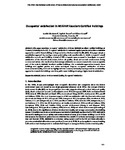Occupants’ satisfaction in BREEAM excellent certified buildings
| dc.contributor.author | Montazami, A | |
| dc.contributor.author | Korsavi, Sepideh Sadat | |
| dc.contributor.author | Howell, G | |
| dc.date.accessioned | 2021-10-09T07:21:34Z | |
| dc.date.available | 2021-10-09T07:21:34Z | |
| dc.date.issued | 2020-01-01 | |
| dc.identifier.isbn | 9780992383572 | |
| dc.identifier.issn | 2209-3850 | |
| dc.identifier.uri | http://hdl.handle.net/10026.1/18020 | |
| dc.description.abstract |
This paper examines occupants’ satisfaction of three BREEAM excellent certified buildings at Coventry University in the UK. Occupants’ satisfaction is evaluated against passive and active sustainable approaches used in these buildings to improve Indoor Environmental Quality (IEQ). This paper adopts a quantitative approach by running a seven-point rating scale questionnaire to obtain occupants’ overall satisfaction score in each building. A total of 180 occupants were surveyed to investigate occupants’ satisfaction of the thermal environment, indoor air quality, visual and acoustic environment during summer and winter. The results show that average satisfaction scores are towards the more acceptable part of the scale in BREEAM Excellent certified buildings. The sustainable approaches towards these buildings and applied passive and active techniques improve occupants’ satisfaction of Indoor Environmental Quality. It should be highlighted that Coventry University has improved its sustainability approaches towards its buildings over time, with newer buildings showing a higher level of satisfaction. | |
| dc.format.extent | 815-824 | |
| dc.language.iso | en | |
| dc.rights | Attribution 4.0 International | |
| dc.rights | Attribution 4.0 International | |
| dc.rights.uri | http://creativecommons.org/licenses/by/4.0/ | |
| dc.rights.uri | http://creativecommons.org/licenses/by/4.0/ | |
| dc.title | Occupants’ satisfaction in BREEAM excellent certified buildings | |
| dc.type | conference | |
| dc.type | Conference Proceeding | |
| plymouth.volume | 2020-November | |
| plymouth.publication-status | Published | |
| plymouth.journal | Proceedings of the International Conference of Architectural Science Association | |
| plymouth.organisational-group | /Plymouth | |
| plymouth.organisational-group | /Plymouth/Faculty of Arts, Humanities and Business | |
| plymouth.organisational-group | /Plymouth/Users by role | |
| plymouth.organisational-group | /Plymouth/Users by role/Academics | |
| dc.identifier.eissn | 2209-3850 | |
| dc.rights.embargoperiod | Not known | |
| rioxxterms.licenseref.uri | http://creativecommons.org/licenses/by/4.0/ | |
| rioxxterms.type | Conference Paper/Proceeding/Abstract |



